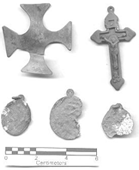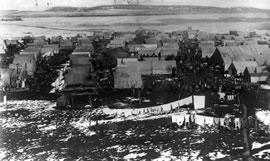

 |
 |

|
The Archaeology of the Colorado Coal Field War is an archaeological project conducted by Binghamton University, Fort Lewis College, and the University of Denver. We are investigating sites from the 1913-1914 coal strike in order to (a) understand how conditions in the coal camps led to the strike and how the strike changed those conditions (b) raise public awareness of the Coal War and the Ludlow Massacre. This project is funded by the Colorado Historical Society, State Historic Fund. For more information please contact Dean Saitta, Anthropology, University of Denver, Denver CO 80208; Philip Duke, Anthropology, Fort Lewis College, Durango, CO 81301; or Randall McGuire, Anthropology, Binghamton University, Binghamton, NY 13902-6000. The Colorado Coalfield War Archaeological Project initially tested the site of Ludlow for three weeks during the summer of 1997 to determine whether there were sufficient and significant archaeological remains from the tent colony to warrant a large-scale archaeological investigation. Having proved that there were, we returned in 1998, 1999, 2000, 2001 and 2002 to conduct intensive archaeological investigations. We also worked at the old Colorado Fuel and Iron (CFI) camp of Berwind a couple miles up the canyon from the Ludlow tent colony during the 1998, 1999 and 2000 field seasons. Volunteers and students from all over the United States and even as far away as Bulgaria and England have come to participate in the project and in our field field school. The project used remote sensing, photographic and archaeological survey techniques to find evidence of life in the tent colony. A combination of these different techniques uncovered not only the tent outlines, but cellar features that were used as trash pits after the massacre and preserved the household items, tools, and personal effects of the miners who lived in the colony. Because of the violent and unexpected end to the first tent colony, most of the personal belongings of the colonists were left at the site when they fled, and therefore remain for us to study today. Remote Sensing and Photographic Overlay |
 Figure 1 |
Areas with Red indicate buried features. Several of these features were tested during various field seasons. |
 Figure 2 |
This historic photograph of the tent colony, taken from a water tower, was used in the photographic overlay technique. |
|
Tent Outlines |
| There appear to be additional tents to the northeast and southwest, and possibly another tent to the north. These ditches that outline the tents were probably for drainage. We also know from photos of the colony that many of the tents had berms of dirt piled up around the outside, probably for insulation and protection against the wind. |
| Using
the historic photographs, we also located another partial tent outline.
However, this one was not as well preserved. A third tent outline, excavated
during the 2001 field season revealed a tent footprint with an associated
ditch around the tent seen in this sketch (Figure 4)
of Features 99 and 100. |
|
Figure 4 |
This field sketch of Features 99 and 100 clearly show a tent outline and its associated ditch. This sketch is from the 2001 field season. |
| Cellars
and Pits |
|
Figure 5 |
Another
interesting feature we found was a deep pit filled with tin cans, bottles,
and other trash. As often happens in archaeology, we found this pit towards
the end of the project, we were not able to excavate as much as we would
have liked. We can say however that it is over 1.10 meters (3.60 feet) deep.
It was a trash pit. One of the first artifacts we found when we started
excavating here was the wire frame for a wreath, lying at the top of all
the trash in the pit. |
|
Upon analyzing the artifacts we found in the pit, we discovered many of the tin cans appear to be for evaporated or condensed milk. One still had a partial label on it, "Pet," which is a brand you can still find today. Other artifacts included tobacco tins, medicine bottles ("Hamlin's Wizard Oil" and "Aceite Mexicano" were the two main brands), a Heinz pickle jar, and whiskey flasks. Lab Work
|
| |
|
Home | Notice | Site Index | DU Anthro Home |